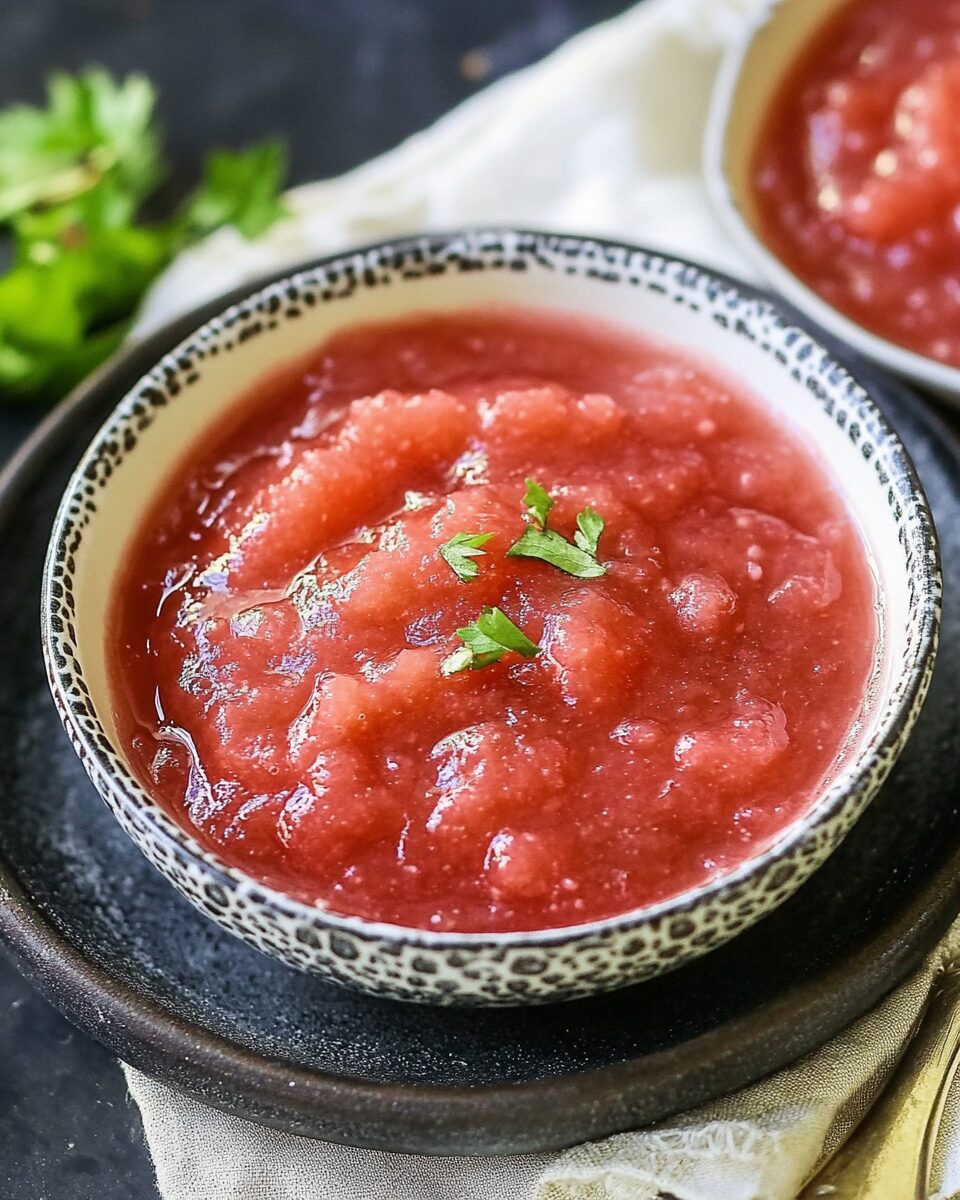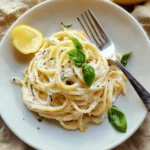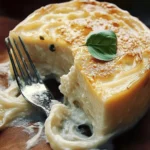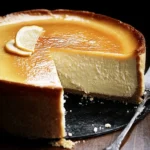This classic rhubarb sauce is a simple and nostalgic recipe that brings out the tangy, sweet flavor of fresh rhubarb. It’s a perfect topping for breakfast dishes like pancakes or yogurt, and it can also be served warm or cold with desserts such as ice cream or cake. Made with just a few ingredients, this quick-cook sauce is a springtime favorite.
FULL RECIPE
Ingredients
- 4 cups chopped fresh rhubarb (about 1/2-inch pieces)
- 1/2 cup granulated sugar
- 1/4 cup water
- 1/2 teaspoon vanilla extract (optional)
Directions
- In a medium saucepan, combine rhubarb, sugar, and water.
- Bring the mixture to a boil over medium-high heat.
- Reduce the heat to low and simmer for 10–15 minutes, stirring occasionally, until rhubarb breaks down and the sauce thickens.
- Remove from heat and stir in vanilla extract if using.
- Serve warm or chilled, depending on preference.
Nutritional Information
- Calories: 60
- Carbohydrates: 15g
- Sugars: 13g
- Fiber: 1g
- Fat: 0g
- Protein: 0g
- Sodium: 0mg
History and Tradition of Rhubarb Sauce
Rhubarb has been cherished for centuries, especially in European and North American cooking. The tangy stalks were originally used for medicinal purposes before becoming a popular ingredient in desserts and sauces. Rhubarb sauce, in particular, is a traditional staple in many households, often passed down through generations as a simple yet flavorful addition to meals. Its old-time charm lies in its ability to transform fresh rhubarb into a versatile condiment enjoyed year-round.
Seasonality and Rhubarb Harvest
Rhubarb is typically in season during the cooler months of spring and early summer. The brief harvesting period encourages cooks to preserve or use it quickly. This sauce celebrates the rhubarb harvest by offering a quick, fresh way to enjoy the vegetable’s natural tartness without long cooking times or complicated preparations. The seasonality also means that the sauce often accompanies other spring produce, creating vibrant, fresh menus.
Flavor Profile and Taste Characteristics
The flavor of rhubarb sauce is distinctly tart with a hint of sweetness, which makes it a refreshing counterpoint to rich or creamy dishes. The balance of sugar added to the rhubarb softens the acidity, allowing the natural flavors to shine without overwhelming the palate. When served warm, the sauce has a comforting, homestyle quality, whereas chilled it offers a crisp and lively taste.
Culinary Uses of Rhubarb Sauce
Rhubarb sauce is incredibly versatile. It can be drizzled over pancakes, waffles, or French toast to add brightness to breakfast. It complements yogurt and oatmeal perfectly, making simple dishes more exciting. For dessert, it pairs well with ice cream, cheesecake, or pound cake, adding a zesty contrast. Savory applications include serving it alongside roasted meats or as a tangy component in sandwiches and salads.
Nutritional Benefits
Rhubarb is low in calories and contains beneficial vitamins such as vitamin K and C, as well as dietary fiber. While the sauce contains sugar, it remains a healthier alternative to many commercial dessert toppings. Its high fiber content aids digestion, and the antioxidants present in rhubarb contribute to overall health. This combination of nutrients makes rhubarb sauce a guilt-free addition to many meals.
How to Choose Fresh Rhubarb
Selecting quality rhubarb is essential for a good sauce. Look for stalks that are firm, crisp, and vibrant in color—usually bright red or pinkish hues indicate freshness and sweetness. Avoid stalks that are wilted or have blemishes. The leaves should be discarded as they contain toxins. Fresh rhubarb will yield a better texture and flavor in the final sauce.
Storage Tips for Fresh Rhubarb
To keep rhubarb fresh before using, wrap the stalks in a damp paper towel and place them in the refrigerator crisper drawer. It’s best used within a week of purchase to ensure optimal taste and texture. If you want to store rhubarb longer, it can be chopped and frozen without blanching, making it convenient for out-of-season use.
Freezing Rhubarb Sauce
Homemade rhubarb sauce freezes exceptionally well. Once cooled, place the sauce in airtight containers or freezer bags. Frozen sauce can be thawed in the refrigerator and reheated gently on the stove or in the microwave. This method preserves the fresh flavor and texture, making it easy to enjoy rhubarb sauce year-round.
Adjusting Sweetness and Flavor Variations
One of the great things about rhubarb sauce is how easily it can be tailored to personal taste. Some prefer it more tart, so they reduce the sugar, while others add more sugar or even honey for extra sweetness. Additional flavorings such as cinnamon, ginger, or orange zest can be incorporated to create unique twists on the classic recipe. Experimenting with spices can bring out different dimensions of flavor.
Pairing Rhubarb Sauce with Other Fruits
Rhubarb pairs beautifully with a variety of fruits. Strawberries are the classic companion, creating a balanced sweet-tart combination. Other berries like blueberries or raspberries work well, as do stone fruits such as peaches and apricots. Combining rhubarb with fruits adds complexity and enhances the sauce’s versatility across different dishes.
Rhubarb Sauce in Baking
Rhubarb sauce can be used as a filling or topping in baked goods. It adds moisture and tang to pies, tarts, muffins, and cakes. Its acidity helps balance the richness of buttery doughs and sweet batters, making desserts more interesting. The sauce can be swirled into batters or layered in between pastry layers for added flavor and texture.
Gluten-Free and Vegan Friendly
This sauce is naturally gluten-free and vegan, making it accessible to many dietary needs. It contains simple, whole ingredients without dairy or gluten, which aligns well with clean-eating trends. This makes rhubarb sauce an excellent option for families or guests with dietary restrictions, ensuring everyone can enjoy its bright flavors.
Using Rhubarb Sauce as a Condiment
Beyond sweet dishes, rhubarb sauce can elevate savory meals. It works wonderfully as a condiment for grilled or roasted meats, such as pork or chicken, where its acidity cuts through richness. It can also be used as a dipping sauce or as a base for salad dressings and marinades, adding a punch of flavor to a variety of dishes.
Cultural Significance and Regional Variations
Different cultures have adopted rhubarb in their cuisines with slight variations. In parts of England and Scandinavia, rhubarb desserts and sauces have a storied history, often reflecting the seasonal availability and local tastes. Variations may include different sweeteners or spices, reflecting regional preferences and traditions, enriching the recipe’s cultural background.
Health Considerations
While rhubarb is healthy, it’s important to avoid consuming the leaves, which contain oxalic acid and are toxic if eaten. The stalks used in sauce are safe and nutritious. People with kidney issues or prone to kidney stones should moderate intake of rhubarb due to its oxalate content. Moderation and correct preparation ensure that rhubarb sauce remains a safe and enjoyable treat.
Incorporating Rhubarb Sauce in Meal Planning
Rhubarb sauce’s versatility makes it a useful item in meal planning. It can be prepared in advance and stored for quick breakfasts or last-minute desserts. It pairs well with seasonal menus, offering a bright, fresh element to balance heavier dishes. Including rhubarb sauce in your kitchen repertoire can simplify cooking while adding flair to everyday meals.
Sustainability and Growing Your Own Rhubarb
Rhubarb is a hardy perennial plant that grows well in many climates, requiring minimal care once established. Growing your own rhubarb can be a sustainable choice, reducing the carbon footprint related to food transportation. Homegrown rhubarb ensures freshness and can inspire more frequent use in homemade recipes like this sauce.
Rhubarb Sauce for Kids and Families
Because of its mild sweetness and bright flavor, rhubarb sauce can be a family-friendly addition to meals. Children often enjoy it on pancakes or mixed into yogurt. Introducing kids to tart flavors like rhubarb early on can help broaden their palate. Making rhubarb sauce together can also be a fun, educational kitchen activity.
Common Mistakes to Avoid
Overcooking rhubarb sauce can cause it to become overly mushy or lose its fresh flavor. It’s important to simmer just until the rhubarb softens and the sauce thickens slightly. Adding too much sugar can mask rhubarb’s natural tartness, while too little can make the sauce overly sharp. Balancing cooking time and sweetness is key to success.
Tips for Serving and Presentation
Serving rhubarb sauce in attractive dishes or jars can enhance its appeal, especially when entertaining. It can be garnished with fresh mint or paired with complementary colors on the plate. Warm sauce is comforting in colder months, while chilled sauce is refreshing in the summer, so presentation and temperature adjustment can elevate the dining experience.
Conclusion
Quick rhubarb sauce remains a beloved recipe for its simplicity, versatility, and timeless flavor. Its ability to brighten both sweet and savory dishes with minimal ingredients makes it a valuable addition to any kitchen. Understanding its background, flavor possibilities, and practical uses encourages creativity and appreciation for this old-time favorite. Whether used as a topping, condiment, or baking ingredient, rhubarb sauce continues to delight taste buds and evoke nostalgic memories while fitting perfectly into modern culinary lifestyles.






